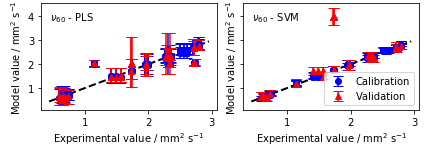Identification, Suitability Testing, and Property Determination from Untargeted Measurements
Summary
Many polymeric fluids, including biotherapeutics and fuels, can have unusual physical behavior in solutions, and many applications require detailed knowledge of their behavior. We use machine learning approaches to predict fluid behavior and physical properties from chromatograms and other analytic data.
Description

NIST is evaluating machine learning approaches as an alternative to physical measurements, to enable prediction of physical or chemical properties of mixtures
In many applications, detailed knowledge of a fluid mixture’s physical behavior is needed. This can include physical properties such as viscosity and qualitative properties such as solubility. For instance, a dissolved polymer may suddenly precipitate out of solution when exposed to saline, and if this were a drug, its efficacy would be markedly reduced. Similarly, as feedstocks transition from conventional oil to unconventional petroleum sources and biomass, it will be necessary to determine whether a fuel or fuel blend is suitable for use in engines.
Currently, the state of the art for such measurements is to make each measurement of each candidate mixture individually. This is intractable, since the number of possible mixtures is quite large. In this project, we study the use of gas chromatography-mass spectroscopy and other analytical data, coupled with machine learning techniques, to develop classifiers and regressors to predict a candidate mixture’s physical or chemical properties, or even make predictions of its suitability for a particular purpose through a library comparison.
Associated Publications
-
Lippa, K. A., Aristizabal-Henao, J. J., Beger, R. D., Bowden, J. A., Broeckling, C., Beecher, C., Davis, W. C., Dunn, W. B., Flores, R., Goodacre, R., Gouveia, G. J., Harms, A. C., Hartung, T., Jones, C. M., Lewis, M. R., Ntai, I., Percy, A. J., Raftery, D., Schock, T. B., Sun, J. C., Theodoridis, G., Tayyari, F., Torta, F., Ulmer, C. Z., Wilson, I., and Ubhi, B. K., "Reference materials for MS-based untargeted metabolomics and lipidomics: a review by the metabolomics quality assurance and quality control consortium (mQACC)," Metabolomics, 18, (2022).
-
Bearden, D. W., Sheen, D. A., Simon-Manso, Y., Benner, B. A., Rocha, W. F. C., Blonder, N., Lippa, K. A., Beger, R. D., Schnackenberg, L. K., Sun, J. C., Mehta, K. Y., Cheema, A. K., Gu, H. W., Marupaka, R., Gowda, G. A. N., and Raftery, D., "Metabolomics Test Materials for Quality Control: A Study of a Urine Materials Suite," Metabolites, 9, (2019).
-
W. F. D. Rocha and D. A. Sheen. Determination of physicochemical properties of petroleum derivatives and biodiesel using GC/MS and chemometric methods with uncertainty estimation. Fuel 243:413-422, (2019).
-
W. F. D. Rocha, M. M. Schantz, D. A. Sheen, P. M. Chu, and K. A. Lippa. Unsupervised classification of petroleum Certified Reference Materials and other fuels by chemometric analysis of gas chromatography-mass spectrometry data. Fuel 197:248-258, (2017).

